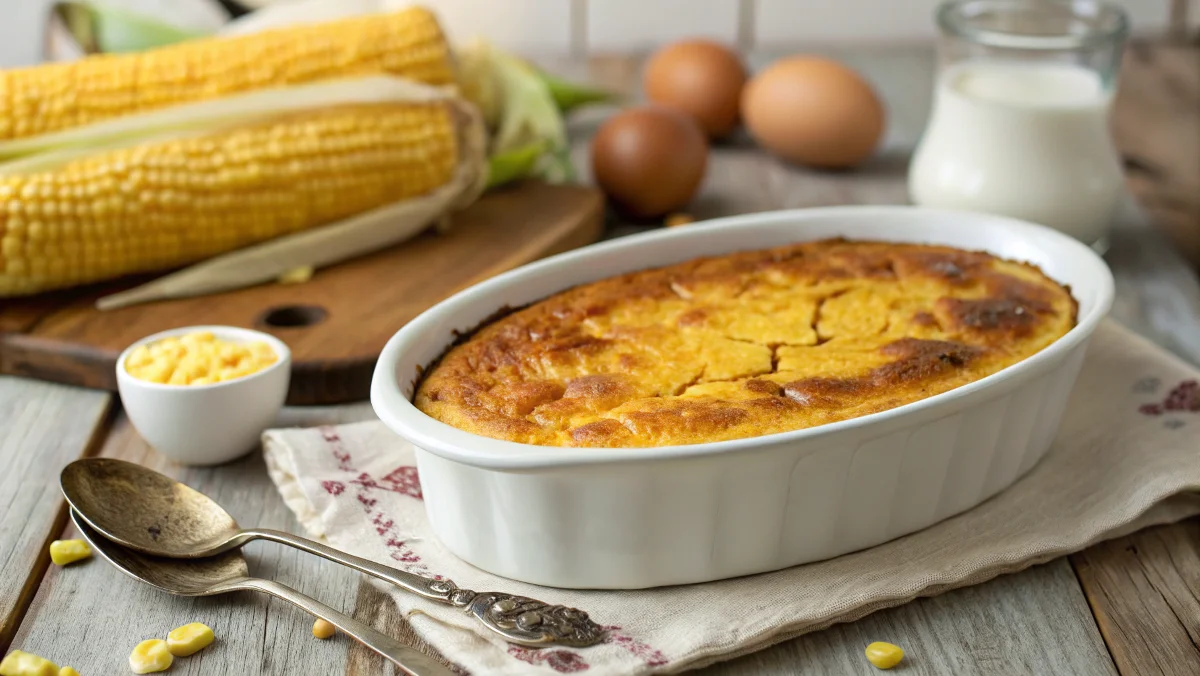Corn pudding is a quintessential comfort food, celebrated for its rich flavor, creamy texture, and versatility. Whether you’re preparing a Corn Pudding Recipe for Thanksgiving, a potluck, or a family dinner, this dish is a guaranteed crowd-pleaser. Its appeal lies in the simplicity of its ingredients, including corn, eggs, cream, and seasonings, which combine to create a dish that’s both hearty and indulgent. This Corn Pudding Recipe is perfect for any occasion, offering a classic side dish that’s easy to prepare and loved by all.
For those who appreciate dishes that seamlessly blend sweetness and savory notes, corn pudding pairs perfectly with various recipes. As an example, the Sweet and Sour Meatballs Recipe – Simple and Flavorful offers an excellent complement, bringing vibrant and contrasting flavors to your table.
In this guide, we’ll delve into the history, ingredients, variations, and best practices to ensure your corn pudding is a hit every time.
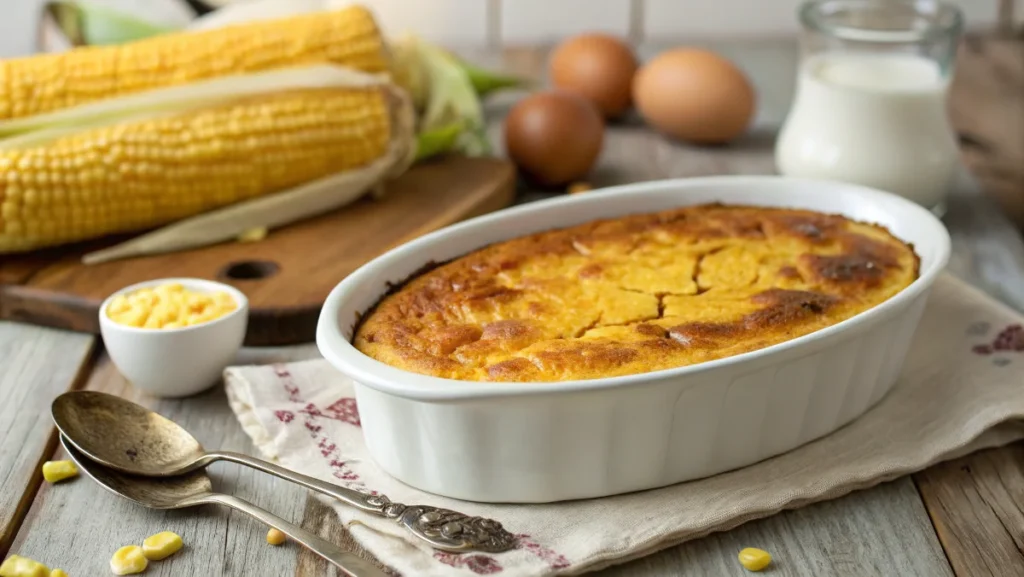
Table of Contents
What is Corn Pudding?
The Origins of Corn Pudding
Corn pudding has been a staple in American cuisine for centuries. Originally inspired by Native American dishes that utilized maize, early settlers adapted the recipe, incorporating ingredients like milk, butter, and eggs. Over time, this dish evolved into the creamy, oven-baked delicacy we know today.
Why Corn Pudding Stands Out
What makes corn pudding unique is its ability to straddle the line between sweet and savory. It pairs the natural sweetness of corn with a custard-like base, making it adaptable for various occasions. Whether served as a side dish or a dessert, corn pudding holds a special place on the table.
Popular Uses
From holiday feasts to summer BBQs, corn pudding is a versatile dish. It pairs wonderfully with roasted turkey, baked ham, or even serves as a hearty standalone option for vegetarians. For those seeking additional inspiration, pairing it with flavorful options like Chicken Thigh Recipes can create a balanced and delicious meal that caters to diverse tastes.
Its rich flavor and satisfying texture make corn pudding a favorite for all ages and a must-have on any menu.
Ingredients Needed for the Perfect Corn Pudding
Essential Ingredients for the Recipe
- Corn: The star ingredient. Fresh corn works best, but canned or frozen corn offers convenience.
- Eggs: A binding agent that creates the pudding’s custard-like texture.
- Milk or Cream: Adds richness and prevents the dish from drying out.
- Butter: Infuses the pudding with a savory, velvety flavor.
- Sugar: Balances the savory notes with a touch of sweetness.
- Flour or Cornmeal: Thickens the mixture, providing structure.
Optional Additions for Flavor
- Cheese: Cheddar or gouda can give a savory twist.
- Spices: Paprika, nutmeg, or cayenne pepper for a subtle kick.
- Vegetables: Diced peppers, onions, or jalapeños for added texture and flavor.
Pro Tips for Ingredient Preparation
- Use fresh corn during the summer for the sweetest flavor. For canned corn, rinse and drain well to remove excess salt.
- Opt for whole milk or heavy cream for a creamier pudding, or choose almond milk for a dairy-free version.
- If adding cheese, grate it finely for even melting throughout the pudding.
Dietary Adjustments
Corn pudding can be customized for specific dietary needs:
- Gluten-Free: Replace flour with cornstarch or gluten-free flour.
- Vegan: Substitute eggs with flaxseed meal and use plant-based milk.
- Low-Calorie: Swap butter with olive oil and reduce sugar.
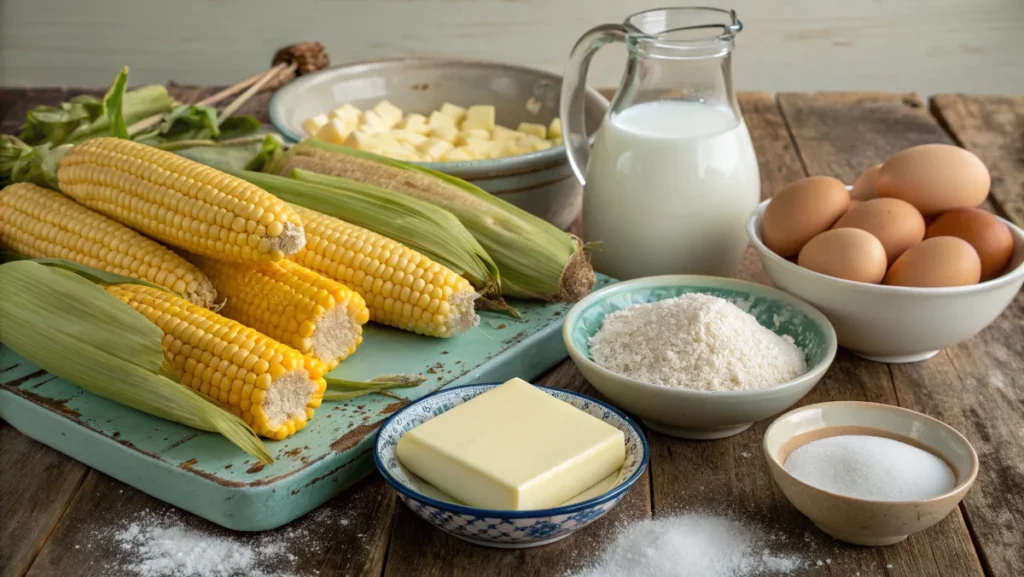
Step-by-Step Instructions
Preparation Steps
- Gather Ingredients: Lay out all ingredients at room temperature to ensure a smooth mix.
- Preheat Oven: Set your oven to 350°F (175°C) and grease a medium-sized baking dish.
- Mix Wet Ingredients: In a large bowl, whisk eggs, milk, melted butter, and sugar until thoroughly combined.
Combining the Mixture
- Stir in the corn kernels, ensuring they’re evenly coated.
- Gradually add flour or cornmeal, stirring to create a lump-free batter.
- If using optional ingredients like cheese or spices, fold them in at this stage.
Baking the Corn Pudding
- Pour the batter into the greased baking dish, spreading it out evenly.
- Bake for 45-50 minutes. The top should be golden brown, and a toothpick inserted into the center should come out clean.
- Allow the pudding to rest for 10-15 minutes before serving to enhance its flavor and texture.
Expert Tips for Success
- Avoid overmixing to maintain the pudding’s creamy consistency.
- For a crispy top, sprinkle extra cheese on top before baking.
- If the edges brown too quickly, cover the dish with foil during the final 10 minutes of baking.
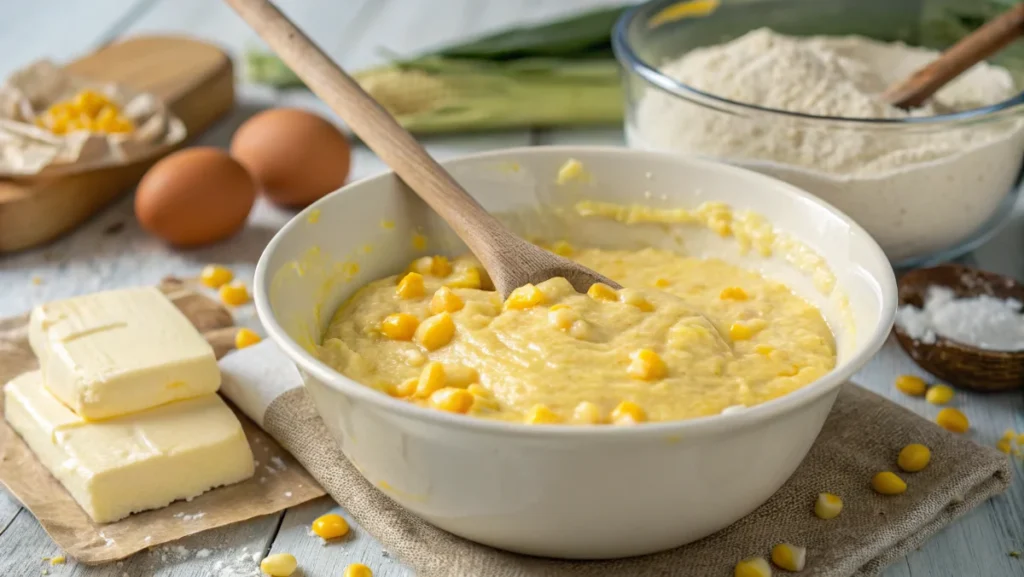
Variations of Corn Pudding
Sweet Corn Pudding
Transform your corn pudding recipe into a dessert by increasing the sugar content and adding a teaspoon of vanilla extract. This sweet version pairs beautifully with whipped cream or a drizzle of honey.
Savory Corn Pudding
Enhance the dish with savory ingredients like crumbled bacon, diced jalapeños, or shredded cheese. For extra flavor, try a blend of smoked paprika and garlic powder.
Gluten-Free and Vegan Options
- Gluten-Free: Swap flour with cornstarch or a gluten-free flour blend.
- Vegan: Replace eggs with a chia seed or flaxseed gel (1 tablespoon seed + 2.5 tablespoons water per egg). Use almond or coconut milk as a dairy alternative.
Regional Twists
- Mexican Corn Pudding: Add chili powder, cilantro, and crumbled cotija cheese.
- Southern Corn Pudding: Incorporate buttermilk for a tangy flavor and serve with hot sauce.
Serving Suggestions and Pairings
Occasions to Serve Corn Pudding
Corn pudding shines during Thanksgiving, Christmas, and Easter, but it’s equally fitting for summer barbecues and casual family dinners. Its universal appeal makes it a dish worth including in every celebration.
Best Pairings for Corn Pudding
- Main Courses:
- Roasted turkey or baked ham during holiday feasts.
- BBQ ribs, fried chicken, or grilled salmon for outdoor gatherings.
- Vegetable Sides:
- Green beans almondine, roasted Brussels sprouts, or glazed carrots.
- A fresh garden salad with vinaigrette for a lighter option.
- Breads and Other Sides:
- Pair with cornbread or dinner rolls for a hearty meal.
- Serve alongside mashed potatoes or macaroni and cheese for comfort food heaven.
Serving Tips
- Garnish with fresh parsley or green onions for added color and flavor.
- Use ramekins to create individual portions for an elegant presentation.
- Reheat leftovers in the oven to maintain the dish’s creamy texture.
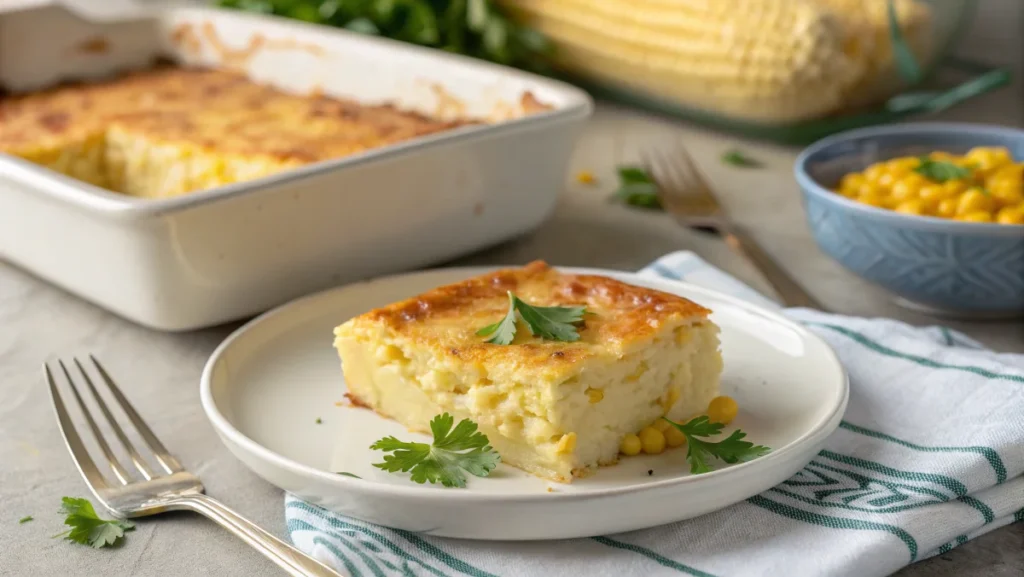
Common Mistakes to Avoid When Making Corn Pudding
Overmixing the Batter
One of the most common mistakes when making corn pudding is overmixing the batter. Stirring too much can break down the ingredients, resulting in a dense, rubbery texture instead of the creamy, custard-like consistency that defines a great corn pudding recipe. To avoid this, gently fold the ingredients together just until combined.
Using the Wrong Corn
Fresh corn is often the best choice for maximum flavor, but canned or frozen corn can be excellent alternatives. However, forgetting to drain canned corn or thaw frozen corn can add too much liquid to the batter, making the pudding soggy. Always ensure your corn is well-prepared before adding it to the mix.
Skipping the Resting Period
Once the pudding is out of the oven, it’s tempting to dig right in. However, skipping the resting period can cause the dish to lose its structure and flavor. Allowing the pudding to cool for 10-15 minutes ensures it sets properly and enhances its taste.
Inaccurate Baking Time
Overbaking can dry out the pudding, while underbaking can leave the center runny. Always check for doneness by inserting a knife into the middle of the pudding. If it comes out clean, it’s ready to serve.
Storage and Reheating Tips for Corn Pudding
Proper Storage Techniques
- Refrigeration: After cooling, transfer leftovers to an airtight container. Refrigerate for up to 3-4 days.
- Freezing: For longer storage, freeze portions in freezer-safe containers. Frozen corn pudding can last up to 2 months.
Reheating Tips
- Oven Method: Reheat in a preheated oven at 300°F (150°C) for 10-15 minutes. Cover with foil to prevent drying out.
- Microwave Method: Heat individual portions in the microwave for 1-2 minutes on medium power. Add a splash of milk or cream to keep it moist.
Avoiding Flavor Loss
To preserve the dish’s rich taste and creamy texture, always reheat it gently. Avoid using high heat, which can dry out the pudding or alter its flavor. Similarly, understanding proper reheating and baking techniques is essential for any dish. For example, when baking lasagna, it’s helpful to know Do you cover lasagna when baking? to achieve the perfect texture and prevent moisture loss.
By applying similar care to your corn pudding, you can ensure that its delightful flavors remain intact, making it a standout dish every time.
Fun Facts About Corn Pudding
A Dish With Native American Roots
Corn pudding originates from early Native American cuisine, where corn (or maize) was a staple food. The early versions were simpler, using basic ingredients like ground corn and water, showcasing the resourcefulness of indigenous people.
A Holiday Favorite
Over time, corn pudding became a staple in Southern holiday traditions. It’s now a common feature on Thanksgiving, Christmas, and Easter tables. Its popularity stems from its ability to complement rich main courses like turkey or ham.
Known By Different Names
Depending on the region, corn pudding may be called “corn casserole,” “corn soufflé,” or simply “corn bake.” While the ingredients may vary slightly, the essence of the dish remains the same—a creamy and satisfying treat.
Versatility Beyond the Table
Corn pudding’s sweet and savory flavor profile allows it to transition effortlessly from a comforting side dish to a delightful dessert when prepared with extra sugar and vanilla.
FAQs About Corn Pudding
1. What’s the Difference Between Corn Pudding and Corn Casserole?
While both dishes are made with corn, they differ in texture and preparation.
- Corn Pudding:
- Creamier, with a custard-like consistency.
- Made with a base of milk, eggs, and often creamed corn for a smooth texture.
- More traditional in Southern cuisine and often served as a side dish.
- Corn Casserole:
- Denser and more bread-like, often due to the addition of cornbread mix (like Jiffy).
- Can include chunks of corn, cheese, or other mix-ins for a heartier dish.
- More versatile and can be served as a main dish or side.
2. Can I Use Canned Corn Instead of Creamed Corn?
Yes, you can use canned corn as a substitute, but there are a few adjustments needed:
- How to Substitute:
- Blend half of the canned corn with some milk or heavy cream to mimic the creamy texture of creamed corn.
- Use 1 cup of blended corn for every 1 cup of creamed corn required.
- Add a touch of sugar and butter for enhanced flavor.
This method ensures the dish remains creamy and flavorful, even without traditional creamed corn.
3. Corn Pudding Pioneer Woman: How does her recipe differ?
The Pioneer Woman’s corn pudding recipe is a popular take on this dish, known for its rich flavor and creamy texture. Her version often includes a combination of fresh corn, creamed corn, eggs, butter, and milk, sometimes with a hint of sugar for sweetness. What sets it apart is the use of simple, hearty ingredients that result in a smooth, flavorful pudding. The recipe is easy to make and ensures a perfect balance of sweetness and savory notes.
4. Why Is My Corn Pudding Watery?
Watery corn pudding can be caused by several factors:
Using Too Much Corn: Overloading the batter with corn can add excess moisture. Stick to the recipe’s recommended amount.
Incorrect Ratios: Too much liquid (milk or cream) relative to the dry ingredients can result in a runny dish. Ensure you measure your ingredients accurately.
Underbaking: If the pudding isn’t baked long enough, the custard won’t set properly. Bake until the center is firm and a knife inserted comes out clean.
Skipping Resting Time: Let the pudding cool for 10-15 minutes after baking. This allows the custard to firm up as it cools.
Conclusion and Final Recipe Tips
Corn pudding is more than just a recipe—it’s a tradition, a comfort food, and a dish that brings people together. Whether you’re hosting a holiday dinner or looking for a versatile side dish, this corn pudding recipe is guaranteed to impress.
Final Tips for Success
- Use fresh ingredients whenever possible for the best flavor.
- Be mindful of proportions to achieve the perfect creamy consistency.
- Customize the recipe with sweet or savory variations to suit your preferences.
With its rich history, endless variations, and universal appeal, corn pudding deserves a place on every table. From the simplicity of preparation to its comforting taste, this dish is a celebration of culinary tradition. As with any layered or baked dish, attention to detail makes all the difference. For instance, mastering techniques like How to Layer Lasagna can elevate your baking skills and ensure perfectly balanced flavors and textures.
Gather your ingredients, preheat the oven, and relish the joy of creating this classic comfort food that everyone will adore.

